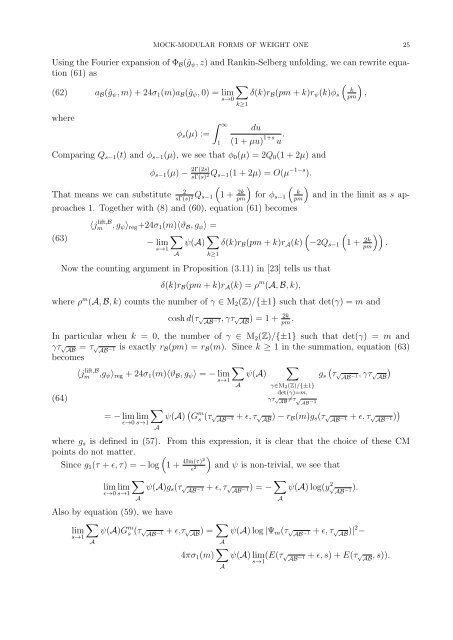Mock-modular forms of weight one - UCLA Department of Mathematics
Mock-modular forms of weight one - UCLA Department of Mathematics
Mock-modular forms of weight one - UCLA Department of Mathematics
Create successful ePaper yourself
Turn your PDF publications into a flip-book with our unique Google optimized e-Paper software.
MOCK-MODULAR FORMS OF WEIGHT ONE 25<br />
Using the Fourier expansion <strong>of</strong> Φ B (ĝ ψ , z) and Rankin-Selberg unfolding, we can rewrite equation<br />
(61) as<br />
( )<br />
k<br />
(62) a B (ĝ ψ , m) + 24σ 1 (m)a B (ĝ ψ , 0) = lim δ(k)r B (pm + k)r ψ (k)φ s ,<br />
where<br />
φ s (µ) :=<br />
∫ ∞<br />
1<br />
s→0<br />
∑<br />
k≥1<br />
du<br />
(1 + µu) 1+s u .<br />
Comparing Q s−1 (t) and φ s−1 (µ), we see that φ 0 (µ) = 2Q 0 (1 + 2µ) and<br />
φ s−1 (µ) − 2Γ(2s) Q<br />
sΓ(s) 2 s−1 (1 + 2µ) = O(µ −1−s ).<br />
( ) ( )<br />
2<br />
That means we can substitute Q<br />
sΓ(s) 2 s−1 1 + 2k<br />
k<br />
for φ<br />
pm s−1 and in the limit as s approaches<br />
1. Together with (8) and (60), equation (61)<br />
pm<br />
becomes<br />
(63)<br />
〈j lift,B<br />
m , g ψ 〉 reg +24σ 1 (m)〈ϑ B , g ψ 〉 =<br />
− lim<br />
s→1<br />
∑<br />
A<br />
ψ(A) ∑ k≥1<br />
pm<br />
( ))<br />
δ(k)r B (pm + k)r A (k)<br />
(−2Q s−1 1 + 2k .<br />
pm<br />
Now the counting argument in Proposition (3.11) in [23] tells us that<br />
δ(k)r B (pm + k)r A (k) = ρ m (A, B, k),<br />
where ρ m (A, B, k) counts the number <strong>of</strong> γ ∈ M 2 (Z)/{±1} such that det(γ) = m and<br />
cosh d(τ √ AB −1 , γτ √ AB ) = 1 + 2k<br />
pm .<br />
In particular when k = 0, the number <strong>of</strong> γ ∈ M 2 (Z)/{±1} such that det(γ) = m and<br />
γτ √ AB = τ√ AB<br />
is exactly r −1 B (pm) = r B (m). Since k ≥ 1 in the summation, equation (63)<br />
becomes<br />
(64)<br />
〈jm<br />
lift,B ,g ψ 〉 reg + 24σ 1 (m)〈ϑ B , g ψ 〉 = − lim<br />
= − lim<br />
ɛ→0<br />
lim<br />
s→1<br />
∑<br />
A<br />
s→1<br />
∑<br />
A<br />
ψ(A)<br />
∑<br />
(<br />
g s τ<br />
√<br />
AB −1, γτ √ AB<br />
γ∈M 2 (Z)/{±1}<br />
det(γ)=m,<br />
γτ √ AB≠τ√ AB −1<br />
ψ(A) ( G m s (τ √ AB −1 + ɛ, τ √ AB ) − r B(m)g s (τ √ AB −1 + ɛ, τ √ AB −1 ) )<br />
where g s is defined in (57). From this expression, it is clear that the choice <strong>of</strong> these CM<br />
points do not matter.<br />
)<br />
Since g 1 (τ + ɛ, τ) = − log<br />
(1 + 4Im(τ)2 and ψ is non-trivial, we see that<br />
ɛ 2<br />
lim lim<br />
ɛ→0<br />
s→1<br />
∑<br />
A<br />
ψ(A)g s (τ √ AB −1 + ɛ, τ √ AB −1 ) = − ∑ A<br />
Also by equation (59), we have<br />
∑<br />
lim ψ(A)G m s (τ √<br />
s→1<br />
AB<br />
+ ɛ,τ √ −1 AB ) = ∑<br />
A<br />
A<br />
4πσ 1 (m) ∑ A<br />
ψ(A) log(y 2 √<br />
AB −1).<br />
ψ(A) log |Ψ m (τ √ AB −1 + ɛ, τ √ AB )|2 −<br />
ψ(A) lim<br />
s→1<br />
(E(τ √ AB −1 + ɛ, s) + E(τ √ AB , s)).<br />
)
















